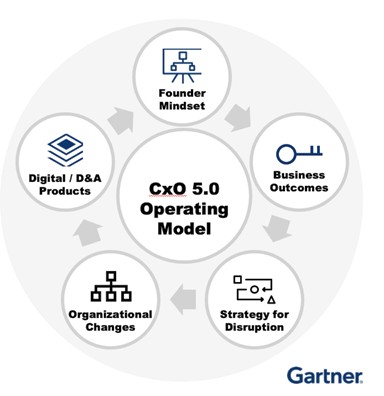The Gartner Research Board has identified a new model for digital leadership that binds together data, analytics, digital technology, and transformation capabilities onto business. The Gartner Research Board said that data and analytics (D&A) leaders are uniquely positioned to drive this change that will make their companies behave like digital natives.

“The most advanced and successful D&A leaders are driving new opportunities to use digital capabilities – often data and analytics products – to capture value. Those opportunities should directly connect to the business priorities,” said Mario Faria, VP and program director at the Gartner Research Board.
He added that some D&A leaders are also using digital and D&A to create whole new business models. “These leaders – the CxO 5.0 – are helping businesses reconstitute by adopting an operating model that grafts native digital capability onto their existing non-digital native businesses,” he added.
The Gartner Research Board’s Global Chief Data and Analytics Officer (Global CDAO) offering provides additional insight on this new operating model and the CxO 5.0 through a community of Global CDAOs engaged with their true peers at comparably sized organisations.

“After we identified how the most successful companies are doing digital reconstitution well, we worked with their CDAOs to create a blueprint of the operating model for others to use, and a maturity tool to identify where a company is on their CxO 5.0 journey,” said Tom Stanton, director of research at the Gartner Research Board.
The CxO 5.0 operating model is based on the idea of grafting, where D&A leaders bring to their companies a way to behave and act like digital natives using five core components (see Figure 1).

Source: Gartner (May 2022)
Five core components
Founder mindset
A founder mindset prioritises solving a problem with minimal waste (time, meetings, etc.). When mapping out strategy, a founder mindset means aligning roles and responsibilities clearly with goals, objectives and incentives clearly explained. “Ensure that there aren’t too many siloed startup mindsets by having a “north star” on the team,” said Faria.
Business outcomes
Organisations should have a clear business strategy with defined alignment to their digital strategy. Leaders should communicate the purpose of data as service to the whole enterprise. To be a data-driven organisation, everyone must own the data and a culture of accountability and alignment must be fostered.
Strategy for disruption
To identify disruption, organisations should operate under the mindset that someone else is already working on a better way. Use data to help create the strategy. Do not use data to try to prove your strategy. CxOs should leverage strength across the organisation for scalability and have the courage to change or cut ties with people, processes and relationships that do not align.
Organisational changes
The goal is to encourage a more decentralised organisational structure that allows for the infusion of skills across the business. To do that, the CxO should start building an organisation that is resilient to frequent people changes and learn how to take advantage of it, such as incorporating on-the-job learning to break down silos.
Digital/D&A products
Organisations should try to enable operations in real-time from resources to insights and create a shift to consistent cross communication. This means moving to a multicloud/cloud agnostic strategy by looking at process and methodology needs to select the platform and build out detailed procedures based on the platform’s capabilities. This will provide the ability to mature and discover new products enabling evolution with new insights.





